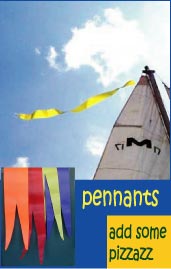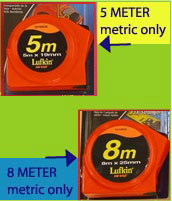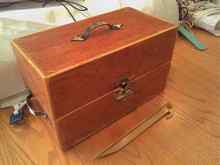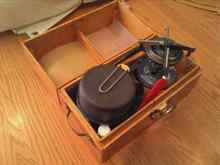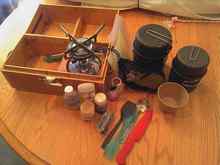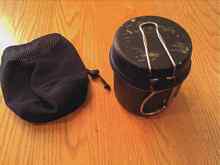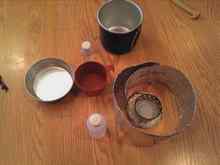In a previous article I shared with you my philosophy on packing light in small boat cruising. It has advantages such as no overloading your boat so you can sail faster, allowing you to use smaller boats for cruising, being able to drag your boat around on land, and being able to find what you need when you need it. In this article I focus on perhaps the biggest challenge to small boat cruising: Feeding the Crew.
As Larry Brown so aptly stated in his book, Frugal Yachting, for some reason we have to either heat food up or cool it down before eating. Wouldn't it be easier if we could just be satisfied with room temperature? This always runs through my mind when cruising on a small boat and, for the most part, I have adapted my preferences to live with room temperature. Nowhere is this more evident than with drinks on-board. Ditch the cooler and ice and you already have saved a lot of weight. Learn to be satisfied with water (or water with a few drops of Mio) and your logistics of staying hydrated just got a lot more efficient. Another way to lighten the load when it comes to drinks is to know your water resupply spots along your route. On freshwater, all it takes is some water purification tablets and possibly a few drops of Mio to hide the taste. On saltwater coastal cruises this is a little harder but not much. This way you do not have to bring along water for the entire duration of your cruise. However, I do bring double the amount I need to get to my planned watering holes in case weather causes me to have to hole up on a beach. I tend to bring a gallon of water a day for warm weather sailing.
I find room temperature food is a little harder to live with for the duration of a cruise. I make my own beef jerky (easy, cheap, and healthy with a food dehydrator), bring nuts, and a bunch of granola bars. I could live on this stuff but would rather not. So, on a cruise I reward myself in the evenings with a hot meal and in the mornings with a hot drink. Thus, I need some sort of system whereby I can heat up stuff.
I have two different galley systems I can choose between when packing for a small boat cruise. The first one I will talk about is by far the more luxurious. I built a small galley box 12"x 6"x 6" approximately. The dimensions were more determined by what I was putting in the box than by anything else. The key item is a primus stove which I find easy to use and reliable. I wanted to be able to use the stove without removing it from the box so that the box itself would augment stability. So, the box I built opens in half allowing easy access to the fuel knob and the stove is held securely by a hole cut to size in one side of the box. I flip open my galley box and the stove is ready to use. One problem I did discover about this stove is that pots tend to slip around and fall off especially when heated unless it is absolutely level, hard to find in small boats especially if anchored out. So, I cut fingers out of aluminum from Home Depot and riveted them onto the stove's cooktop. The fold out and accommodate themselves to all different sized pots.
The second requirement is pots and pans to cook in. I was lucky to find a real nice anodized aluminum set of two pots whose lids made small but able to be used frying pans. They fit into the other side of the box without a problem. Inside of these I pack two plastic cups with handles cut off and my dish washing kit consisting of a small bottle of soap, small sponge, and a piece of a super soaking towel. In the crevices by the stove and the pot I store hand sanitizer, olive oil (makes good nonstick and a butter substitute on bread), salt and pepper shaker, four tiny containers of my favorite spices, two sporks, a knife, a tiny spatula, water purification tablets, a lighter, and windproof waterproof matches. In the top of the lid I have tucked two cutting boards with the white one used for meats and the yellow for veggies. With this setup I can boil, fry, and bake almost any meal I want. The two pots will bake with the small put inside the large. Having the small pot also allows me to heat up some water while eating my meal. I eat either out of the pots or use the small plastic cups as bowls if I am cooking for guests.
The second galley system is much smaller consisting of one pot painted, with black engine block paint for efficiency, a cat can alcohol stove, small container of denatured alcohol, a plastic cup and (not shown) a spork and a pocketknife. The cat can stove is an ingenious invention made out of a small aluminum can of catfood by simply removing the catfood and punching two rings of holes using a hole punch. The pot creates a top to the stove forcing the boiling alcohol out of the holes where it ignites causing a nice circular burner flame. With fuel, this stove weights near ounces yet can boil a good amount of water. Given a lack of temperature control, boiling water is about all it is good for though. Also, alcohol stoves are very vulnerable to wind and have an invisible flame so using them on a boat in the wind can be difficult and possibly dangerous. I use an aluminum foil windscreen to help with the former and tend to cook on the beach for the latter. Besides, some piled sand helps to block the wind.
I always bring food that doesn't require refrigeration. The only cooler you will find on my boats is for the rare treat of cold beverages on a hot day. Fortunately, grocery stores these days are full of great meals you can cook that don't require refrigeration, are less expensive than dehydrated backpacking meals, and taste better as well. My favorite aisle is the canned meat where I can get very good canned chicken, beef in gravy, pork, and a whole variety of fish in foil packet. This meat can be added to a variety of different rice mixes, noodle mixes, powdered potatoes, and etc. to make a wonderful tasting hot meal after a long day of sailing. One of my favorite meals is a can of chicken mixed in with a half bag of Knorr teriyaki noodles which I season to taste with some ginger and other ingredients. For bread I prefer those flatbread sandwich rounds which are not as prone to crushing as bread or I make my own using premixed powder in a ziplock baggie. I add a little water to the powder, mix by squeezing the bag, then bake in a smaller pot inside a larger or fry in the pan. I do the same thing for pancakes in the morning with some protein added by Spam. Powdered sugar or maple syrup are easy to pack. I also will use pancakes as a nice treat as is biscuits with honey drizzed over them.
Well, that is all for now as I am suddenly starving and it is lunchtime!
|


